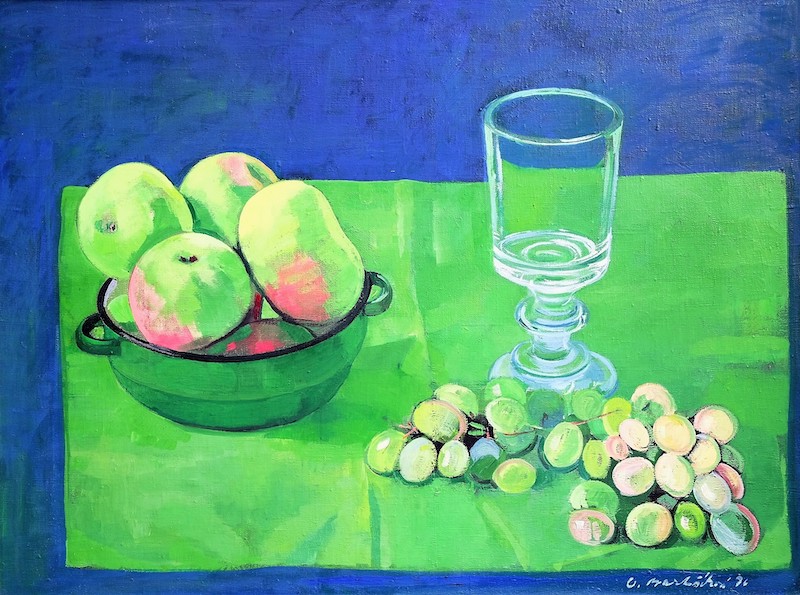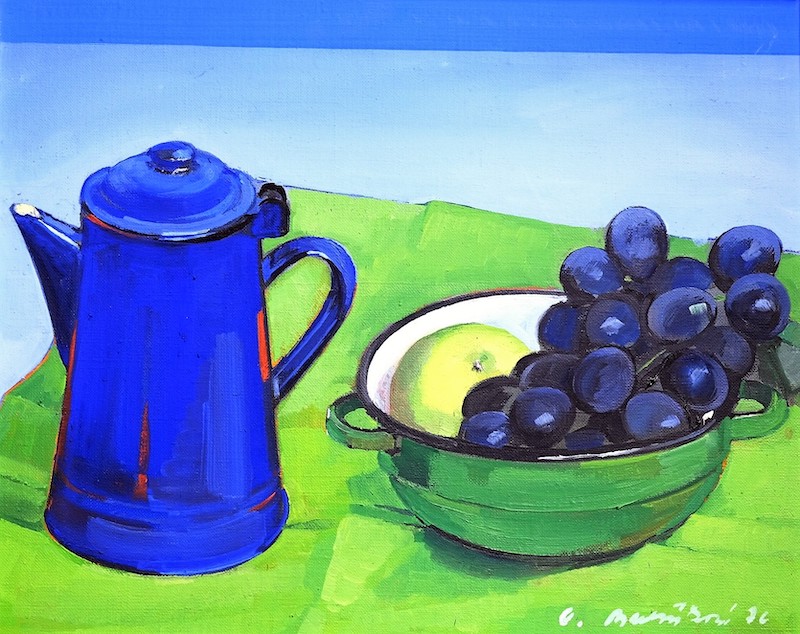Oľga Bartošíková’s work now stretches over a seventy-year period and records an unusual number of approaches and the artist’s never-ending search for a unique expression style that responds to trends at the current domestic and worldwide art scenes. Despite different formal approaches towards painting, drawing, but also installations, her works contain recurring themes and motives that appear in different series: fragments of the human body, motives of fruits and flowers, architecture details (windows, walls), but also various forms of life and beauty on one side and changes, disappearances and destruction on the other. In the first period of her work, the late 1950s, Bartošíková’s painting was based on expressionism resulting in a flat, decorative form. In the 1960s, her work turned towards rather dark abstract themes that were more tragic (lonely figures, burning cathedrals), with her visual language resembling Art Informel popular at the time. At the turn of the 1960s and 1970s, she focuses on installations and environments inspired by Neofiguration and Pop art that she uses to depict flat silhouettes and parts of female body (hands, eyes, mouths). The early 1970s and the beginning of the Normalisation Era in Czechoslovakia triggered her interest in Hyperrealism as she painted mostly still lifes with enlarged fruit, incorporating large flat areas of contrasting colors and adding glass bottles and glasses with refined light reflections later on. In the 1980s, her still lifes depict various studio objects (brushes, colors) and in the second half of the 1980s, after losing her house in her birth town of Holíč, Bartošíková depicts her memories in figurative family portraits or meditative images capturing fragments of the already gone house. She has spent the last two decades creating still lifes and figurative motives bordering with Neo-Concretism and Abstract Art dealing with the ephemeral. From the 1960s to 1989, Oľga Bartošíková also created several monumental works in architecture in different places across Slovakia using various techniques, mostly ceramics and stucco lustro. Probably the most famous one was a relief wall at the M. R. Štefánik Airport in Bratislava which, just like many other of her works in public space – was destroyed during the reconstruction of the building.
Nitra Gallery’s collection includes two of her paintings, Still Life with Apples and Still Life with Plums and a Kettle that date back to the 1970s when Oľga Bartošíková painted mostly hyperrealistic still lifes. Bartošíková’s Hyperrealism is different from Photorealism, which was especially popular in the United States at the time. The depicted objects are painted very realistically, but we can also see the brush strokes and structures created by the individual color layers. So in her case, it is more of a classical realistic, veristic or objective depiction of reality. As Štefan Zajíček writes: “The artist’s central source of inspiration comes from her never-ending captivation by the world of objects that surround her – flowers, fruit, glass. She tries to penetrate deep inside them, capture them and reward them with immortality.” [1]
The first paiting titled Still Life with Apples depicts a simple blue background with a standard enamelled bowl full of apples in the front, accompanied by a glass and a bunch of grapes, all lying on a green tablecloth. The other painting contains rich tones of blue in the background, the kettle and plums and various shades of green in the apple, tablecloth and the bowl. The paintings feature very rich colors and capture bright light that both evoke positive mood. The canvases in the Nitra Gallery’s collection are unique within the context of Oľga Bartošíková’s other works as she usually painted apples, oranges or lemons, but these contain a rare presence of grapes and plums. [2]
Oľga Bartošíková was born on August 18, 1922 in Holíč. From 1945 to 1950, she studied painting at the Academy of Fine Arts in Prague at the Studio of Painting led by professor Ján Želibský. In 1951, she married a Czech art theorist and critic Ľubor Kára who was the editor in chief of the Výtvarný život [Fine Art Life] magazine (1957-1971) and curator of important exhibitions like Sculpture Parks of Piešťany, Polymusical Space, Danuvius. In 1951, they had a daughter Darina who is the director of the International Theatre Festival Divadelná Nitra and in 1955, they had another daughter Elena who is a sculptor. In 1957, Oľga Bartošíková and her family moved to Bratislava where she became a member of the Union of Slovak Fine Artists. In 1958, she joined painters Jarmila Čihánková, Tamara Klimová and Viera Kraicová and they founded Group 4 that existed until 1967. She is a member of the Slovak Union of Visual Arts – Society of Free Artists. She lives and works in Bratislava. More about her life and works can be found on her website www.olgabartosikova.sk
Omar Mirza
May 2020
Bibliography:
[1] ZAJÍČEK, Štefan – KUBÍKOVÁ, Klára: Oľga Bartošíková. Senica: Záhorská galéria Jána Mudrocha, 2018, ISBN 978-80-89724-35-2, p. 104.
[2] ibid, p. 102.
Inventory No.: O-862
Artist: Oľga Bartošíková
Title: Still Life with Apples
Year of origin: 1976
Technique: oil
Material: canvas
Dimensions: 60 × 80 cm
Signature: bottom right, in brush: O. Bartošíková 76
Inventory No.: O-863
Artist: Oľga Bartošíková
Title: Still Life with Plums and a Kettle
Year of origin: 1976
Technique: oil
Material: canvas
Dimensions: 38 × 46 cm
Signature: bottom right, in brush: O. Bartošíková 76

